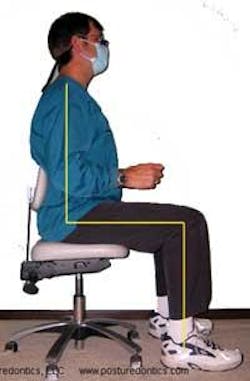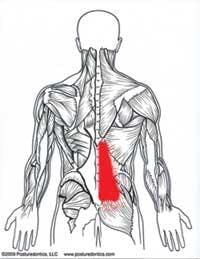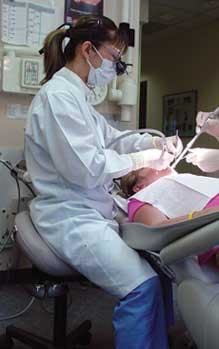Does your operator stool trigger low back pain?
by Bethany Valachi, MS, PT, CEAS
For more on this topic, go to www.dentaleconomics.com and search using the following key words: ergonomics, Bethany Valachi, iliopsoas, trigger points, lumbar curve, Posturedontics, physical therapy.
At some point in the transition to seated dentistry, it was decided that the perfect position of the seated dentist should be with the body's major joints at right angles. This stuck — until recently.
If you are sitting right now, you're probably in a chair with a flat seat. If so, don't move your spine. Place one hand on your low back and feel the position of your lumbar spine. Without moving your hand, scoot to the edge of your seat so that your thighs slope downward. Did you feel the position of your lumbar spine change? If you are like most people, the spine moved from flat to a curved position.
This is a reason operators may “perch” on the edge of a flat seat — to place their spines in a more balanced posture.
Most dentists and hygienists were taught to sit with their thighs parallel to the floor, or their hips at a 90-degree angle (Fig. 1). This paradigm for seated work has been widely accepted for generations, and may be due in part to the design of early operator chairs, which featured a flat, nonadjustable seat design.
The nature of dentistry makes intermittent forward leaning virtually unavoidable. This combination of thighs parallel to the floor with forward leaning causes the pelvis to roll backward and flatten the low-back curve. Research shows that this flattening of the lumbar curve has detrimental effects on both the spinal musculature and discs. Muscular activity in the lower back increases, which can cause ischemia. Pressure within the disc also increases, which can lead to premature disc degeneration. Research supports positioning the hips higher than the knees, which allows for increased hip angle with lower associated low-back muscle activity and disc pressure.
Chairs with a tilting seat feature open the hip angle to about 110 degrees, (saddle-style stools open to about 135 degrees) which maintains the low-back curve, decreases disc pressure, enables closer positioning to the patient, and helps reduce low-back pain.
Maintaining this essential low-back curve also places the spinal curves above it in a more balanced posture, minimizing strain on the other spinal discs, muscles, and ligaments. While I have discussed the reasons for tilting or saddle-style stools extensively in past articles, there is an even more compelling reason for those 90-degree sitters who suffer from low back pain.
Trigger points in the iliopsoas (hip flexor) muscles can develop as a result of sitting in a 90 degree (or less) hip angle, referring pain to the low back.
As a dental professional, you have probably already experienced trigger points, whether you realize it or not. A trigger point is a group of muscle fibers that are in a constant state of contraction. It feels like a hard knot, and when pressed upon may be painful or may refer pain to a distant part of the body.
The involved muscle tends to become tight, short, and weak. Trigger points may be active (painful) or latent (causing stiffness and restricting range of motion). Because they are caused by prolonged muscle contraction, postural asymmetry and mental stress (among other factors), it is easy to see why trigger points are so common among dental professionals. They are often the cause for “mysterious” low back pain syndromes that elude Western medicine practitioners.
The iliopsoas (pronounced ilio-so´-az) muscle is especially vulnerable to developing painful trigger points due to the seating biomechanics inherent to delivering dental care. The muscles function primarily to flex the hip and are constantly activated while the practitioner sits actively (not resting on a backrest), which is a majority of the time for most operators.
Iliopsoas trigger points are especially aggravated by prolonged sitting with the hips acutely flexed 90 degrees or more (i.e., on a non-tilting seat pan). Although the muscle is located on the front of the body, trigger point pain from this muscle is usually referred to the low back (Fig. 2) and sometimes the upper buttocks and interior thigh. Pain is common when standing and walking, and relieved when lying down, sitting, or flexing the hip. Trigger points in this muscle can cause improper posture, which aggravates other muscles and leads to trigger point development in them.
Identifying tightness in the hip flexor muscle requires a special test called the Thomas Test, which is performed by a physical therapist or similar health-care practitioner. There is also palpable tightness and pain in the muscle. The quadratus lumborum muscle should be assessed for involvement, as these two muscles are often “partners in crime.”
Effectively treating trigger points is essential, and should be done by a health-care practitioner trained in trigger point therapy or who has a certified neuromuscular therapist (CNMT) designation. Weak abdominal and gluteal muscles contribute to trigger points in the iliopsoas muscle in seated occupations such as dentistry. A strengthening program that addresses muscle imbalances inherent to dentistry targets such muscles.
Prevention of iliopsoas trigger points
• Hip angle. Sit with a hip angle greater than 105 degrees. A stool with a tilting seat pan or a saddle stool works well (Fig. 3). It is also possible to retrofit a nontilting stool with an ergonomic wedge-shaped cushion. When selecting a stool with a tilting seat pan, be sure to look for highly textured material to prevent sliding forward on the seat. Most operator stools with tilting seat pans tilt forward farther than necessary.
Only 5 to 15 degrees of tilt is necessary to attain a downward sloping thigh angle. When you use the tilt feature for the first time, only tilt the seat about 5 degrees for the first few weeks. You can gradually work your way up to 10 to 15 degrees. Tilting the seat too far forward can cause excessive curvature (hyperlordosis) of the lumbar spine and should be avoided.
• Iliopsoas stretch. Sit on the edge of a chair (with no armrests and no wheels) with one buttock hanging off the edge. Let the outside leg drop down, and slide the foot backward until a stretch is felt in the front of the thigh. Hold for two to three breath cycles.
• Prone push–up. This is a yoga move, also known as the cobra. Lie facedown on the floor, with hands at shoulder level. Slowly push up, keeping hips pressed against the floor. Hold 30 seconds.
• Hamstring stretch. There are many ways to stretch the hamstring muscle. Always ensure your knee is straight and you are bending forward from the hips, not the back. Tight hamstrings can cause a posterior tilt of the pelvis, which can overload the iliopsoas muscle. Hold for 30 seconds.
The benefits of a tilting seat pan are numerous, including the prevention of iliopsoas trigger points that can lead to low back pain. However, there are many potential causes of low back pain, which is why you should always consult your doctor for proper diagnosis. With a conscientious routine of ergonomic strategies in the operatory and proper stretching/strengthening, low back pain caused by problem trigger points in the iliopsoas muscle can be prevented.
Bethany Valachi, PT, MS, CEAS, is a physical therapist, dental ergonomic consultant, and CEO of Posturedontics®. A clinical instructor of ergonomics at OHSU School of Dentistry, Valachi lectures internationally. She covers the above topics and more in her new book, “Practice Dentistry Pain-Free,” available at www.posturedontics.com or by calling (503) 291-5121.



